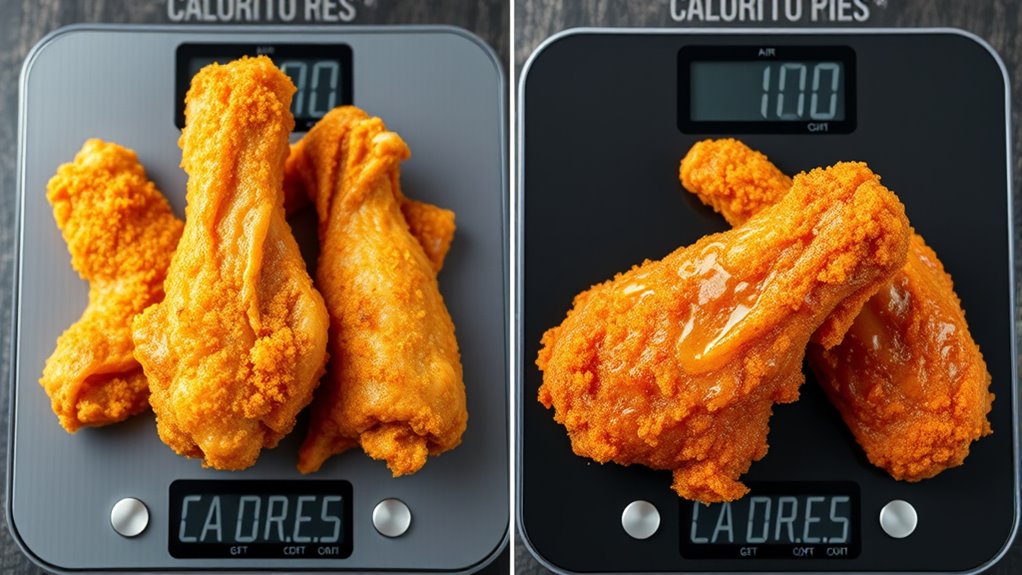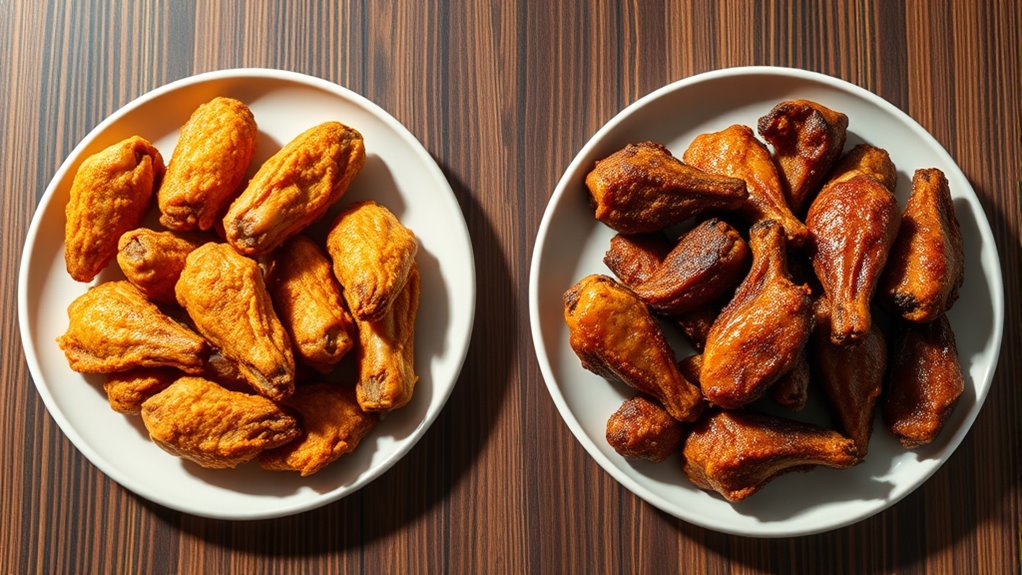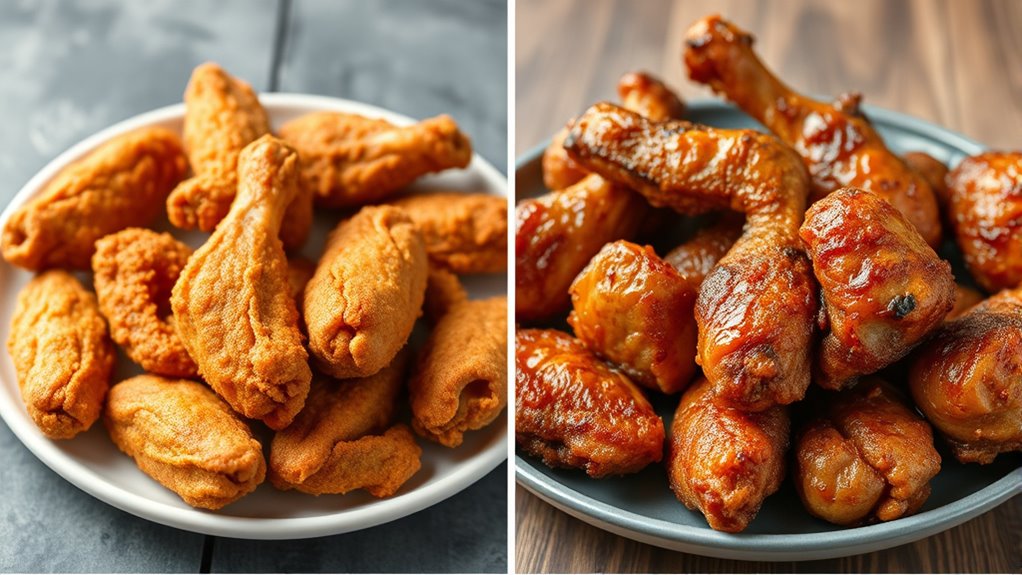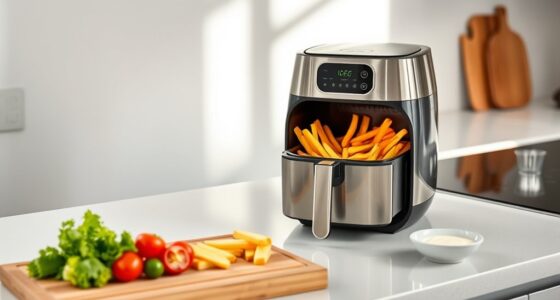Air frying reduces calorie content by about 25-50% compared to deep frying because it uses less oil, making it a healthier choice. Deep frying adds more calories through oil absorption, often resulting in higher energy-dense foods. By choosing air frying, you cut fat and calorie intake without sacrificing crunch or flavor. To discover how different foods compare and get tips for healthier frying, keep exploring the details below.
Key Takeaways
- Air frying typically reduces calories by 25-50% compared to deep frying due to less oil absorption.
- Deep-fried foods often contain 300-600 calories per serving, while air-fried versions are generally lower.
- Proper coating and cooking techniques in air frying further decrease oil uptake and calorie content.
- Air frying preserves flavor and texture with less fat, making it a healthier, lower-calorie cooking method.
- Portion size impacts calorie differences, but overall, air frying offers a significant calorie reduction over deep frying.
Understanding the Basics of Air Frying and Deep Frying

Although both air frying and deep frying cook food quickly and result in crispy textures, they do so using different methods. With deep frying, you submerge food in hot oil, which cooks it rapidly and creates a golden, crunchy exterior. The oil’s high heat transfers directly to the food, producing a rich flavor and moisture retention. In contrast, air frying uses circulated hot air to cook food, mimicking frying’s crispiness without submerging it in oil. You usually coat or spray the food lightly before air frying, making it a healthier alternative. While deep frying often results in more oil absorption, air frying relies on convection to achieve a crispy exterior with less fat. Understanding these fundamental differences helps you choose the right method based on your health goals and taste preferences. Additionally, advancements in AI technology are being integrated into kitchen appliances to optimize cooking times and results, further enhancing air frying techniques.
How Calorie Content Is Calculated in Fried Foods

Calculating the calorie content of fried foods involves more than just looking at the raw ingredients; it requires accounting for how much oil the food absorbs during cooking. When you fry food, it soaks up oil, increasing its calorie count beyond the ingredients’ original calories. To estimate this, you consider the food’s weight before and after frying, noting the oil absorption. Laboratory analyses or standardized calculations help determine the average amount of oil absorbed per food type. Manufacturers and nutritionists use these methods to provide accurate calorie counts. Proper frying techniques, such as controlling temperature and frying time, can minimize oil absorption, leading to healthier fried foods. Keep in mind, the longer or hotter the frying process, the more oil the food tends to absorb, which raises its calorie content. Additionally, oil absorption rates can vary based on the type of food and frying method, influencing the final calorie count. Understanding frying techniques and their impact on oil uptake can help you make healthier choices. For example, using temperature control effectively can reduce excess oil absorption during frying, resulting in lower-calorie foods. This process ensures your calorie estimates reflect the true energy content of fried foods.
Typical Calorie Counts for Deep-Fried Items

You’ll notice that deep-fried foods usually fall within a specific calorie range, depending on their size and ingredients. Popular options like fried chicken, French fries, and mozzarella sticks tend to be higher in calories than you might expect. Understanding these typical counts can help you make smarter choices when enjoying your favorites. Additionally, knowing about the refrigeration cycle can be useful for properly storing leftovers to maintain freshness and safety. Being aware of nutritional content and portion control can also assist in managing overall calorie intake and supporting your health goals. personality assessment tools can also help in understanding your own preferences and habits related to food choices and lifestyle.
Standard Calorie Range
Ever wonder how many calories are in your favorite deep-fried foods? Typically, a deep-fried item ranges from about 200 to 600 calories per serving. For example, a small piece of fried chicken can have around 250 calories, while larger portions or battered items might reach 500 or more. The calorie count depends heavily on ingredients, batter thickness, and portion size. Most fast-food deep-fried foods fall into the 300 to 500-calorie range, making them energy-dense options. Keep in mind that eating multiple servings quickly adds up. Understanding this standard calorie range helps you make informed choices and manage your intake better, especially when comparing with healthier air-fried alternatives. Additionally, the rustic aesthetic of fried foods can make portion control more challenging.
Popular Deep-Fried Foods
Have you ever wondered how many calories are in your favorite deep-fried snacks? Popular options like fried chicken tend to pack around 300-400 calories per serving, depending on portion size and batter. French fries typically contain about 365 calories for a medium order, while onion rings can have 200-300 calories per serving. Mozzarella sticks often range from 80-100 calories each, mostly from breading and cheese. Chicken nuggets usually clock in at 50-70 calories per piece, but that adds up quickly with multiple pieces. Fish and chips can reach 700-900 calories, especially with large portions. Knowing these counts helps you make informed choices and compare them to healthier alternatives like air frying. Additionally, budgeting tips can help you allocate resources toward healthier cooking methods like air frying.
Typical Calorie Counts for Air-Fried Items

Air frying generally reduces the calorie content of popular foods compared to traditional frying methods, but the exact counts still vary depending on the ingredient and portion size. For example, a typical serving of air-fried chicken tenders contains around 200-250 calories, compared to 300-400 calories when deep-fried. Similarly, air-fried French fries usually have about 150-180 calories per serving, while deep-fried versions can reach 300 calories or more. Breaded items tend to retain fewer calories because less oil is absorbed during air frying. Overall, you can expect a 25-50% reduction in calories for many fried favorites. Keep in mind, portion size plays a vital role, so controlling servings helps maximize calorie savings while enjoying your favorite crispy foods.
Factors Affecting Calorie Differences Between Methods

Several factors influence how much calories differ between air frying and traditional frying methods. Your choice of ingredients, such as added oils or breading, markedly impacts calorie content. Cooking time and temperature also matter; longer or hotter cooking can lead to more oil absorption or moisture loss, affecting overall calories. Additionally, the type of food influences calorie variation—thinner cuts absorb less oil, while thicker pieces soak up more. cooking techniques can also influence the final calorie count by affecting how much oil is retained or lost during cooking. Proper cooking methods help optimize healthfulness and calorie control. Implementing dehydration and moisture loss techniques during cooking can further reduce calorie content by minimizing oil retention.
Comparing Specific Foods: Chicken Wings, French Fries, and Fish Fillets

When comparing the calorie content of chicken wings, French fries, and fish fillets prepared through air frying versus traditional frying, differences often hinge on how each food interacts with oil and coatings. Air frying requires little to no added oil, so it typically results in fewer calories. For chicken wings, air frying reduces calories by eliminating excess oil absorbed during deep frying, though the skin and seasoning still add some calories. French fries prepared in an air fryer use minimal oil, decreasing overall calorie count compared to deep-fried versions. Fish fillets also benefit from air frying, as they retain moisture without soaking up as much oil. Additionally, natural flavor preservation in air frying helps maintain the original taste and texture of foods with less fat. The health benefits of reduced fat intake further support choosing air frying as a healthier cooking method. Overall, air frying generally produces lower-calorie versions of these foods, making it easier for you to enjoy your favorites with fewer calories.
The Impact of Batter and Coating on Calories

The type and thickness of batter or coating you choose can considerably influence the calorie content of your fried foods. Thicker coatings, like bread crumbs, trap more oil, boosting calorie count. Light, thin coatings reduce oil absorption and calorie intake. Opting for healthier ingredients, such as whole-grain or egg wash, can lower overall calories. The Fokos platform emphasizes the importance of ingredient choices in managing calorie intake. Additionally, the batter consistency can impact how much oil is absorbed during frying, influencing the final calorie count. Understanding the 16PF traits underlying food preferences can also aid in making healthier choices. Moreover, awareness of the WWE Raw’s Financial Impact reveals how entertainment industries influence economic perceptions of value, paralleling how food choices can reflect personal priorities.
Tips for Reducing Calories in Fried Foods

To cut calories in fried foods, start by using healthier oils like olive or avocado. Be mindful of how much oil you use; limiting it can make a big difference. Small changes like these can help you enjoy fried favorites with fewer calories. Incorporating oil consumption habits strategies can also diversify your health and financial portfolio. Additionally, considering the calorie content of oils can guide you in selecting the best options for frying. Understanding macronutrient ratios can help optimize your dietary choices for overall health and weight management.
Use Healthy Oils
Using healthy oils is one of the simplest ways to cut calories when frying foods. First, choose oils high in healthy fats, like olive or avocado oil, which are more nutrient-dense. Second, opt for oils with a high smoke point to prevent breakdown and excess calorie absorption. Third, avoid reusing oil, as it can degrade and increase calorie content. Fourth, measure the oil used rather than pouring directly, so you control how much ends up in your food. These simple swaps help reduce unnecessary calories and improve overall health. By selecting the right oils and using them wisely, you make fried foods healthier without sacrificing flavor. Remember, small changes can considerably impact your calorie intake and long-term wellness.
Limit Oil Amount
Controlling the amount of oil you use is one of the most effective ways to cut calories in fried foods. When deep frying, use just enough oil to submerge your food partially or fully, but avoid excessive amounts. For air frying, there’s little to no oil needed, which already reduces calorie content. If you must use oil, measure it carefully with a teaspoon or a spray bottle, so you don’t overdo it. Toss ingredients in minimal oil or brush lightly to add flavor without extra calories. Removing excess oil after frying by draining on paper towels also helps reduce calorie intake. By limiting oil use, you cut unnecessary fats and calories, making your fried foods healthier without sacrificing taste.
Making Healthier Choices: Which Method Is Better?

When choosing healthier options, understanding which method best reduces calorie intake can make a significant difference in your overall health. Air frying generally uses less oil, resulting in fewer calories and less fat. Deep frying adds significant calories due to the oil absorbed during cooking. To help you decide, consider these points:
Choosing air frying reduces calories and fat compared to deep frying.
- Calorie Content: Air frying reduces calories by eliminating or minimizing added oil.
- Fat Levels: Air fried foods typically have less fat compared to deep-fried options.
- Cooking Time: Air fryers cook faster, helping preserve nutrients and reduce overall calorie load.
- Health Impact: Less oil means lower risk of cardiovascular issues over time.
Choosing air frying can be a smarter, healthier way to enjoy crispy foods without the extra calories and fats of deep frying.
Frequently Asked Questions
Are There Significant Flavor Differences Between Air-Fried and Deep-Fried Foods?
You might notice flavor differences between air-fried and deep-fried foods. Air frying often produces a crisper exterior with less oil, which can slightly change the taste and texture. Deep frying tends to give foods a richer, more indulgent flavor due to the oil absorption. While both methods can be delicious, your preference depends on whether you prioritize a lighter, less greasy flavor or a more traditional fried taste.
How Does Cooking Time Impact Calorie Content in Both Methods?
You’re asking how cooking time influences calorie content in both methods. Think of it as hitting two birds with one stone; longer cook times can lead to more fat loss if excess oil drips away, lowering calories. Conversely, undercooking might leave more oil absorbed, increasing calorie count. So, adjusting cooking time carefully impacts the final calories, regardless of whether you’re air frying or deep frying.
Do Air Fryers Produce Fewer Harmful Compounds Than Deep Fryers?
You might wonder if air fryers are safer than deep fryers. Air fryers use hot air, which reduces the formation of harmful compounds like acrylamide and advanced glycation end products (AGEs). Deep frying, especially at high temperatures, can create more of these harmful substances. So, by choosing an air fryer, you generally produce fewer harmful compounds, making it a healthier cooking option.
Can You Achieve the Same Crispy Texture With Air Frying as Deep Frying?
Imagine biting into a perfectly crispy piece of fried chicken—now, with an air fryer, you can get that same crunch. While air frying uses hot air to crisp food, it might not always match the deep fryer’s golden, bubbly exterior. However, with the right technique and a little patience, you can achieve a satisfying crunch that closely rivals deep frying, all without the excess oil.
How Do Portion Sizes Influence Calorie Comparisons Between Methods?
Portion sizes play a significant role in calorie comparisons between air frying and deep frying. When you control portion sizes, you can better manage your calorie intake regardless of the cooking method. Larger portions naturally contain more calories, so even if air frying uses less oil, bigger servings can offset those savings. Paying attention to portion sizes helps you make healthier choices and accurately compare the calorie content of your favorite foods.
Conclusion
So, if you want to save thousands of calories and turn your snack obsession into a health revolution, switch to air frying today! It’s like having a magic wand that transforms greasy monsters into guilt-free delights overnight. With just a simple switch, you’ll be blasting away excess fat and calories faster than you can say “healthy eating.” Say goodbye to calorie overload and hello to the tastiest, lightest, most exciting food adventure of your life!









